Accredited by the Office of the Children’s e-Safety Commissioner, thousands of children have experienced our BCyberwise modules at school. But, what about support for parents?
It’s never too early to teach your child positive habits when it comes to technology and the online world, but with so much information, where do you start? To help you and your family navigate this ever-changing environment safely, we have compiled this page and a downloadable ebook.
In this guide you will find…
FREE Cybersafety Parenting eBook
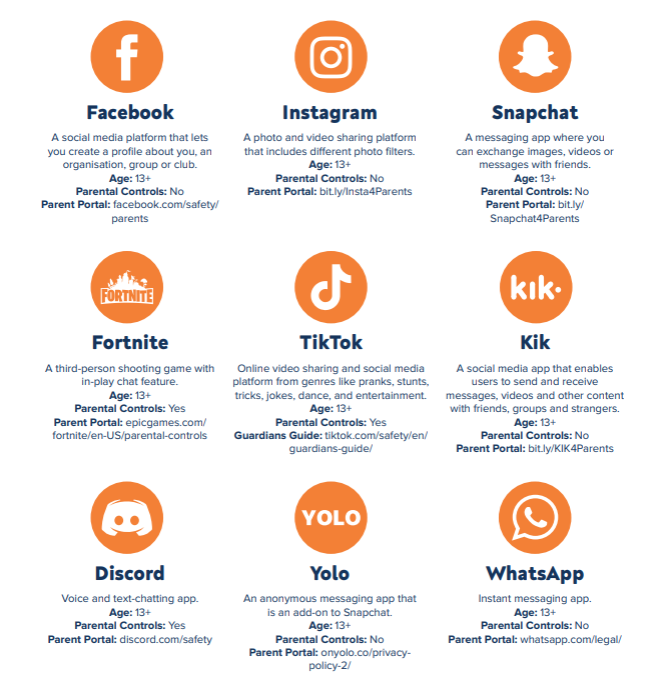 App Guide for Parents
App Guide for ParentsKeeping up with the ever growing list of apps and online platforms is a challenge for every parent. So how can you make sure you know your TikTok from your Yolo?
Download your FREE Quick Apps Guide for Parents below – hang it on your fridge or somewhere where you can grab it easily next time your child asks to join a platform you’ve never heard of!
For a deeper dive into some of the newer platforms, check out this handy blog. It’s filled with practical cybersafety tips for the whole family, including a some of the newer platforms gaining popularity amongst children.
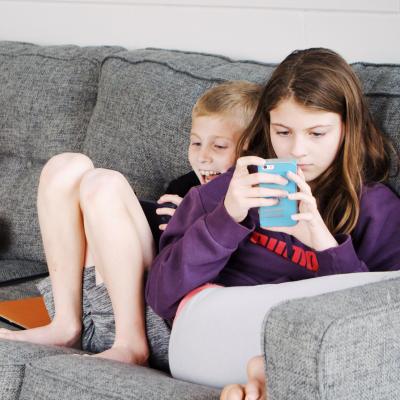 Managing screen time
Managing screen timeWith one in four Queensland children now considered overweight or obese, the amount of screen time our children enjoy has become a key focus for health professionals and parents alike.
It’s true that digital devices are playing an increasingly important role in young lives, but how can we as parents create a balance between the online and offline world?
Join us as we explore the problems and benefits of screen time for your child. There are a lot of actionable tips and tricks to help you and your family put down the device and get active offline.
Read more on reducing screen time

Few people know as much about the cyber world as Brett Lee.
As a former detective specialising in child exploitation, Brett spent countless hours investigating child sex offenders, posing as a teenager so he could prosecute scores of predators who preyed on children.
After working on high-profile cases handled by the Department of Homeland Security, the FBI, and the Australian Police Force, in 2001, Brett decided to utilise his experience to educate people on how to avoid the pitfalls of the online world. He founded Internet Safe Education, and has reached thousands of students, teachers, and parents, spreading the message of online awareness and responsibility.
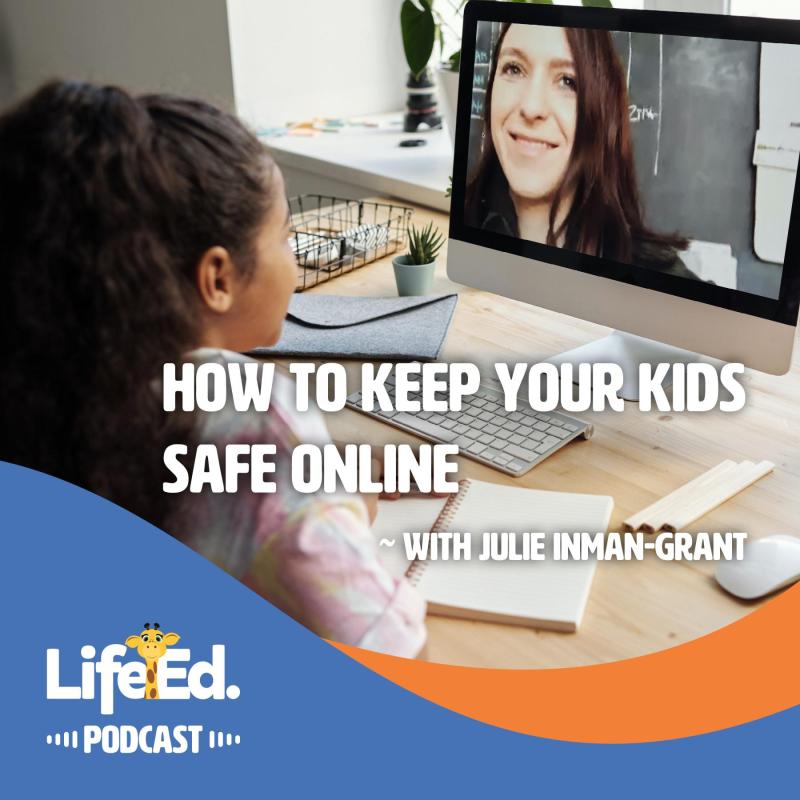
Keeping kids cybersafe can be a minefield for parents.
From cyberbullying to avoiding online predators, there’s so much for parents to know in the digital age.
In this Life Education podcast, Australia’s respected eSafety commissioner Julie Inman-Grant chats with host Tracey Challenor about how parents can stay one step ahead when it comes to helping their kids navigate the online world. Julie heads the only government office in the world dedicated to the safety of citizens online, providing Australians with a place to report online abuse.

According to the Office of the eSafety Commissioner, a digital citizen is a person with the skills and knowledge to effectively use digital technologies to participate in society, communicate with others and create and consume digital content.
Digital citizens are aware of their own behaviour and how it affects others. They act respectfully and encourage others to do the same.
Tips for parents:
Digital citizens understand the technologies that are available and how they can be used to connect with outers. They also know how they can affect their digital reputation.
Digital citizens think before they act – making informed decisions about what information they share and with who.
Tips for parents:
Children have a great number of ways and reasons to be online; there are also an increasing number of internet-connected devices in our homes. With so much data travelling to and from our homes, protecting our family’s privacy online has never been more important.
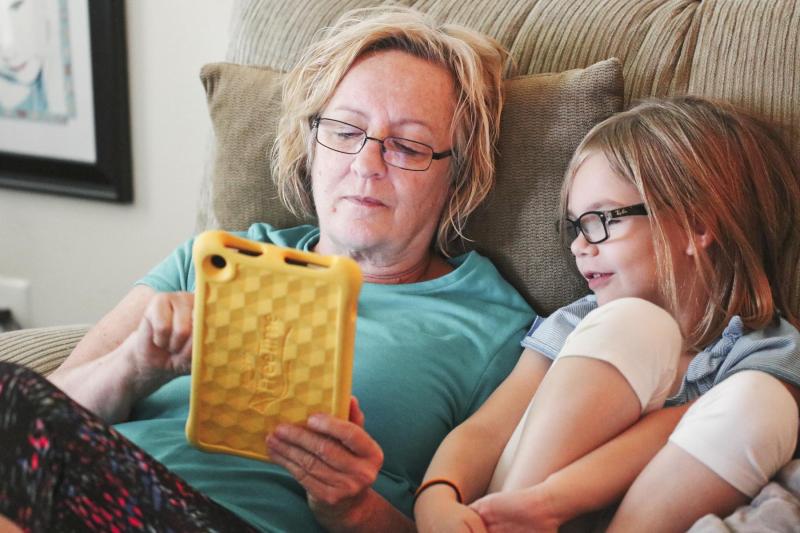
Thanks to Trend Micro, follow these seven and keep your family safe online:
In a growing digital world, the list of required skills is seemingly endless. To help manage this effectively as parents, let’s focus on two elements; respect and empathy.
As parents, it is our job to monitor and guide our children. In doing this if we ensure they are always respectful and behave as if the people on the “other side of the screen” are real people too, they’ll make better and safer decisions.
Cybersafety essentials: Help children to set personal boundaries and how to act if they are breached.
Why not set up a designated area where all devices can be charged – and stored? This is a great way of extricating the devices from bedrooms at night.
Many families are opting to set out expectations for online behaviour in a formal agreement. This can include time spent online, sites that can be visited and what information is suitable to share online.
Yes, all of them. This is a great way to truly understand how it all works. You’ll also establish a little ‘tech cred’ – which means your kids are more likely to come to you if there is a problem.
If your kids come to you with a problem they are experiencing online, it is essential that you do NOT ‘go crazy’ and threaten to disconnect them. If you do this, I can guarantee that you will never hear about another problem again, which isn’t ideal. Our kids need us to help them problem solve. So, pledge to stay calm. Perhaps invest in yoga classes or a meditation app!
Sharing stories of things you have seen online such as workmates slightly inappropriate Facebook posts – and the consequences – with your kids is a great way of starting a real conversation about safe digital behaviour. Parenting in the digital age is definitely not easy. In fact, it can be really hard. So, let’s make the journey a little easier and share our know-how and experiences. Make yourself a cuppa and check out our series of vodcasts.
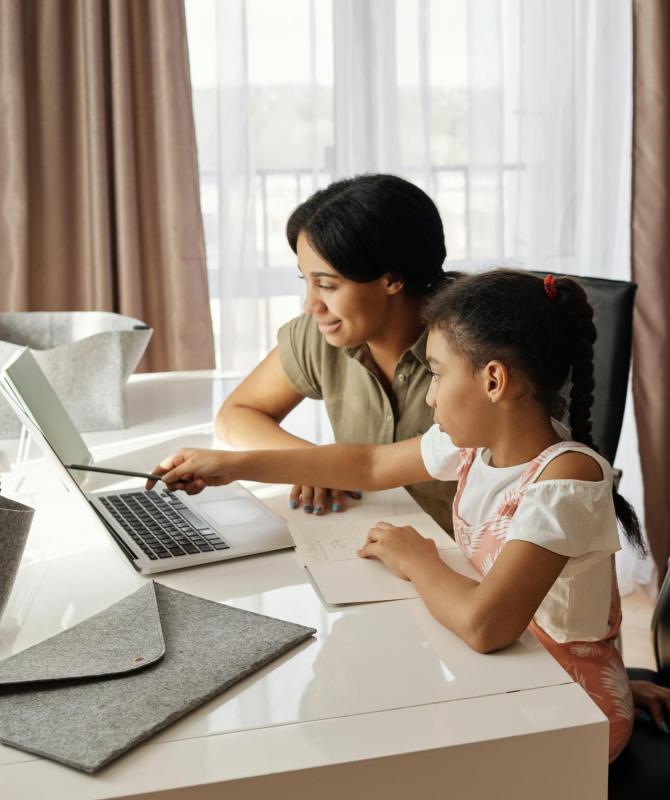 Online privacy and your child
Online privacy and your childThe internet and technology are essential parts of young people’s lives and as digital natives, their thoughts and opinions about privacy and safety can be quite different to ours. An understanding of the risks, along with a few simple strategies, can go a long way toward making the internet a safer place for your children.
Know the risks
If your child shares personal information online such as their phone number, address or location, you would be understandably worried. There are other types of sharing to be aware of too. Pictures shared online can easily spread further than intended. If sharing pictures of your child, be aware of identifying factors such as school names on uniforms or sporting club locations. This type of information could lead to scams, spam, fraud and even identity theft.
Protecting your child’s privacy
Protecting your child’s (and your) privacy isn’t always going to be easy, but there are steps you can take to promote online safety. And remember, no one should be afraid to ask for help.
Get involved in their digital habits
Understand how your children are using technology and the internet and explore the privacy settings of devices, apps and websites together. Don’t know where to start? Explore the eSafety Guide for tips.
Be a role model for good privacy practices
Set strong passwords and think twice before sharing or tagging photos. If you see images of you or your children online that concern you, ask that they are removed. Find out how to share photos privately with family and friends.
Share age-appropriate advice with your children
Toddlers (2 – 5 years of age) | start building good habits by:
Children (6 – 17 years of age) | Responsible digital citizenship includes:
Technology and the internet have become an integral aspect of everyday life for kids in Australia. It is their primary source of information and preferred method of consuming media (like music, films, file sharing and games) and is increasingly a key component in their social interactions.
Because of this, it is essential that families work together to ensure that all members are practising cybersafety, respectful and appropriate online behaviour in the home.
The following strategies below that have been developed to help your family achieve this:
TIP 1: Create an environment of mutual trust with your child so they feel comfortable talking to you about their online experiences.
Create a safe space to discuss cybersafety. This is particularly important so your children know that there will be no punishment for speaking up about cyber bullying (whether victim or bystander). This could prevent them experiencing cyber bullying or could assist one of their friends who is being cyber bullied.
Building trust with your children can be as simple as sharing your own experiences, keeping in touch with their online activities and offering support and practical advice rather than harsh punishments.
No form of bullying is OK and should be reported to a trusted adult immediately.
TIP 2: Work together with your child to discuss responsible online behaviour, appropriate websites and applications.
Decide together exactly what is okay and what is not okay to do online. Highlight the chat rooms and forums that are appropriate for children to participate in such as monitored chat rooms. Make sure your children avoid “.alt” chat rooms, which focus on alternative topics that may be inappropriate for young people.
At the same time, discuss the kinds of things your children can discuss online and the language that is considered inappropriate.
TIP 3: Be involved in how your child uses digital devices.
Set up your computer in a high-traffic family area and negotiate realistic time limits with children for online activities.
Setting usage guidelines will prevent distraction at school and encourage a healthy night’s sleep, assisting a balanced lifestyle.
This can be a bit difficult if your children have their own laptops, tablets, or mobile phones, which can’t be so easily monitored. We recommend that you discuss the amount of screen time the family is comfortable with and monitor your children’s use. Balance screen time with physical activity and non-screen-based activities.
Encouraging the use of digital devices in shared areas of the home area will encourage children to be more open with their online habits. With this in mind, it’s recommended that you aim to keep digital devices out of their bedrooms, especially at nighttime.
TIP 4: Consider your personal digital behaviour and work at becoming a good role model.
An effective tool for influencing the relationship that the children in your household have with technology and the internet is to lead by example. Children model their behaviour from observing the actions of parents, friends and teachers so reassessing your personal use of technology can be a valuable tool in creating a safe and healthy environment. Taking the “do as I say, not as I do” approach might affect short-term behaviour, but it is your behaviour more than anything which will shape your children’s attitudes towards technology.
TIP 1: Be sure you have reputable computer security software with parental controls installed.
Try to discuss some online security issues with your children, focussing on the areas where they can contribute to making themselves safe online. Explain the reasons for wanting to use certain online tools which are designed to protect you and your family. It’s always best to know the cybersafety programs available to you.
In addition, there are certain tasks you can undertake to ensure your family’s security. Make sure you have robust security software that protects your computer against viruses, hackers, and spyware. This software will also be able to filter offensive content, pictures, and websites.
These tools should be updated frequently, as new threats are emerging daily, so security that updates automatically is the best choice.
TIP 2: Learn how to report offensive content to the websites and social networks which your child is permitted to use.
Search engines allow you to turn on safe searching which means that no adult content will appear within search results and all social networking sites enable users to report and/or block offensive content. After discussing what constitutes responsible online behaviour and how to deal with content that makes your children uncomfortable or upset, sit down together and go to the sites your children like to use. Go through the options and processes that they can go through in order to manage their privacy settings and report any offensive content.
It’s important to also remind your children that they can immediately seek your help if needed and that it’s okay to simply get offline and stop using the computer or digital device if they come across something or someone that makes them upset. There are links to more information about specific social networks’ security and privacy help pages in Strategy 3.
TIP 3: Help your children create strong passwords that are difficult to crack and change them regularly
As with your own personal passwords, teach your children that having a combination of letters, numbers and punctuation marks are the best type of passwords to use. Go through some examples with them and help them to create a password that will be fairly easy for them to remember, but still difficult to crack.–For example: a child whose name is Jack and whose favourite colour is red can be something like J@ckRed1.
Discuss with your child the dangers of sharing personal passwords or accounts with their friends and encourage them to ensure that these are protected. Remember, your password is your online digital signature, and it is important that no member of your family shares or reveals this.
Discuss how comfortable all members of the family are for parents to have access to their children’s passwords and set expectations for what level of access parents will have to their children’s accounts.
TIP 1: Educate the family on the importance of cybersafety, online privacy and protecting their personal information.
There are a number of steps that families can take to protect their personal information. This can be as simple as understanding who can access the information that is shared online. Some social networking sites encourage users to tie their account to their real-world identity and this means that families should be vigilant with what information they choose to post on these accounts. Sharing information such as phone numbers or photos that can be used to locate or identify you in the real world (your city, school name, street signs, identifying landmarks) can expose your family to dangers. Some social networks allow you to modify or delete information which has been published about you (including removing tags which identify you or a family member within photos).
In addition to this, remind yourself that many of the people in your social networks should be considered ‘strangers’, especially those who are friends-of-friends.
TIP 2: Remind your children that people they meet online are strangers.
Initiate conversations about how we think about friends and strangers. No matter how well we feel we know someone online or how much we have chatted to or emailed them, they are still strangers. Talk about how it is easier to give false information when talking to people online than it is in real person-to-person interactions. This can be true of people who are ‘friends-of-friends’ in your social networks.
Decide as a family the rules about opening any attachments sent by those who are not trusted family friends. In addition, discuss with your child how important it is for them to talk to you about anybody they meet online who suggests meeting up in the real world.
TIP 3: Talk to your children about their online reputation and how the choices that they make can follow them.
When communicating online, decisions about what to post are often made in the heat of the moment and this can lead to information being shared that members of your family might regret after the fact. bCyberwise.
Whilst it is possible to delete these posts, comments, photos or videos from personal accounts, the moment these posts are published online other users can copy or share them and your family won’t have control over what happens to them. It’s important to be aware that some Social Media sites have the right to use your information or photos collected on their site without informing you, and this may impact your child well into their adult life.
It is also important to discuss as a family that one-on-one conversations such as direct messages, texts or private chat rooms can be recorded and shared.
 Cyber future – Australia in 2025
Cyber future – Australia in 2025How do you feel about the future? Excited? Scared? Apprehensive? Positive?
Well, regardless of how we feel, the future is inevitable. It’s a done deal.
In an effort to prepare us for the future, futurist Ross Dawson have teamed up and put together some predictions for Australia’s future in 2025.
Entitled ‘Safeguarding the Future of Digital Australia in 2025’, this fascinating report contains predictions about how we will be living our lives in just 10 years’ time.
While there are no guarantees, the forecasts are based on extensive research, analysis of trends and interviews of academics and thought leaders (no tarot cards!) so we’re in good hands! And if we are able to understand how the world may change, we will be able to better develop the skills required and navigate the challenges along the way so we can keep safe and enjoy the ride.
Absolutely fascinating, isn’t it?
But it seems that many Aussies have mixed feelings about the future. In fact, recent research shows that only 49% of us are comfortable with technology taking a more dominant role in our daily lives. 42% of us think technology is making life more complicated and only a third of us feel safe and secure in our increasingly digital world.
As parents, embracing change and progress is essential. How can we guide our offspring through a constantly evolving world if we haven’t jumped onboard ourselves? Putting our head in the sand is not an option.
So, if you are feeling a little overwhelmed at the thought of such change, here are my top tips to reduce your anxiety and get you back on track:
Australia in 2025 will clearly be an exciting place to be. Our future is bright and full of opportunities.
If you want to spend some quality time with your child while reinforcing safe online behaviour, download this ‘Chatterbox’ and play along!